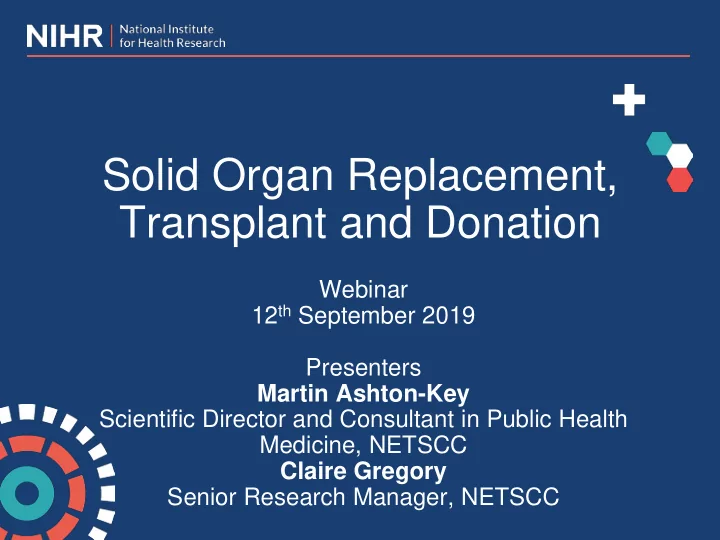

Solid Organ Replacement, Transplant and Donation Webinar 12 th September 2019 Presenters Martin Ashton-Key Scientific Director and Consultant in Public Health Medicine, NETSCC Claire Gregory Senior Research Manager, NETSCC
Questions Please type any questions you have as we go along and we will attempt to answer them either in later slides or at the end of the webinar We will make copies of the slides, questions and answers available following the webinar
Session overview • Introduction • The research brief • Tips for successful applications
About NIHR • The National Institute for Health Research (NIHR) invests in research to help the NHS and care providers meet the major health and social challenges they face • NIHR funds research that has the potential to improve the health of patients, the public and health and care services
Participating programmes
Purpose of the call We want to overcome barriers and challenges to organ donation. To do this we want to commission research in the following broad areas: • Donor and organ assessment • Donor management • Organ and donor perfusion • Transplantation • Post-transplant care • “Next wave” of transplantation
Context • In 2018, more than 6000 people were on the transplant list, and 1166 people died due to lack of available organs • Black, Asian and ethnic minority communities more likely to need a transplant but wait longer due to low consent rates in those communities • Donation of organs following death (both following brain-stem death DBD and following circulatory death DCD) present challenges
Context • Donation following death (DBD and DCD) rates are much lower than living donation • Although living donation rates are higher, there is still room for improvement • We are looking for applications in the areas mentioned that will improve the number and quality of transplantable organs
What are we NOT looking for? We are not including blood and stem cell studies in this call. get the new NIHR branded ones to select from
General Points • Applicants will apply to the cross-programme call, not to a specific programme • Applications must be in remit of one, some or all of the NETS programmes – EME, HTA, HS&DR and PHR – info on website • Welcome applications comprising of co-ordinated teams of investigators spanning several disciplines and centres • Welcome large and ambitious proposals • Applicants should address research following patient need and co-production
Tips for a good application • Explain why your research is important • Clearly state how research addresses an explicit evidence gap – with reference to a review of the evidence and ongoing research • Consider user acceptability and uptake – involve PPI • Consider and justify why the research is good use of public money. How does it have the potential to improve health and care? • Consider your dissemination methods and audience from the outset – how will you demonstrate the impact of your research? • Consider and explain any potential conflicts of interest
Tips for a good application • Get the right team – multidisciplinary, relevant skills • Deliverability – recruiting sites / participant numbers (research following patient need) • Realistic estimate of costs at stage 1, full costs at stage 2 – allow enough time for information gathering • Presentation to committee – information should be clear to non-experts in the area • Include diagrams, such as flow diagram or consort diagram for a trial
Scientific robustness • Appropriate and robust design and methodology to deliver the required study outcomes – explain your choice • Clear and well justified sample size and effect size – show your workings and cite relevant references • Outcome – appropriate to the question (involve PPI) • Backed by a Clinical Trials Unit (where appropriate)
Involve the public & patients Public and Patient involvement (PPI) matters to the NIHR • Embed PPI in your study at early stage and throughout the life of the project • Consider how public and patients will be involved in o Study design / application o In the study itself o In dissemination of the results • Clarify in the application how public and patients will be involved (and include any associated costs)
Stage 1 applications • Internal remit and competitiveness check • Stage 1 applications will then be considered by the most appropriate funding committee
Stage 2 applications • If shortlisted you will have about 8- 10 weeks to produce a second stage application • Stage 2 applications will be peer reviewed • Second stage applications will then be considered by funding committees and a recommendation to fund or not is made • Recommendations to DHSC for funding
Tips for a good stage 2 application • At stage 2 – feedback received from the funding committees is meant to be helpful • Applicants should ensure they respond fully to all areas highlighted by the funding committee – even if don’t agree with the feedback received • Proof read – errors in application lead to reduced confidence in the team – ensure changes made between first and second stage application are consistent throughout
Further support for researchers • NIHR Research Design Service • NIHR Website, NIHR Journals Library website, NIHR Open Data Platform, NIHR Funding and Awards website • Enquiries - whether remit or process, contact the email address provided in commissioning brief crossprogramme@nihr.ac.uk
Apply by 1pm on Wednesday 27 November 2019 GOOD LUCK!
Any questions?
Recommend
More recommend